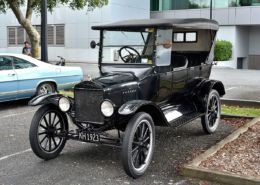1,168 words
By temperament and by instinct I have a need for the superfluous. — Gabriele d’Annunzio
For many of us, cars are no more than devices necessary for getting from point A to B. They can become a real burden, crushing their owners with payments while rapidly depreciating in value. And in many regions and countries, taxes, toll roads, and parking fees add to the cost of driving so substantially that it becomes almost a luxury to own a car.
A new car is a formidable enabler of freedom, of course. It allows its owner to travel anywhere, at any time, without sticking to a public transportation schedule. It is — more or less — a symbol of speed and an expression of the individual. It is a private cocoon, sometimes the last refuge where a man is left alone for any meaningful amount of time. And, nota bene, the car is intensely hated by our rulers (oh, they like theirs).
Unfortunately, they have succeeded in ruining the experience to a considerable extent. Not only are roads littered with speed limits and surveillance cameras, the car itself is being turned into a surveillance device that observes its driver, incessantly corrects his driving style, and will snitch on him at the behest of the authorities. I am not going to dispute a certain value in safety and emissions regulation; for whatever it’s worth, such regulation saves dumb drivers from the consequences of their ineptitude, and it has helped to eliminate harmful emissions to a large degree.
Sadly, this same regulation has also made modern cars fat, ugly, and boring. Today’s premium cars with their suite of “assistance systems” make any self-respecting driver slash his wrists in desperation. And that’s why almost all of them get a hard “no” from me.
The proper alternative to driving a modern car, of course, is not public transportation. It is owning a classic car — as a treat for special occasions, or even as an everyday driver. Interestingly, many regulators try to shut the use of classic cars down, but some countries recognize them as part of their cultural and industrial heritage and protect your right to own and use them.
Choose beauty
Owning and driving a classic car is, above all, a more or less sublime statement of aesthetics. Choosing one is an intensely personal act that reflects the owner’s style and taste. Some cars are chosen because they evoke personal experiences; they turn a childhood dream into reality. Some offer a raw driving experience that no modern car can offer. And others can be appreciated for their industrial and technological significance, or simply as works of art.

You can buy Kerry Bolton’s Artists of the Right here.
A lot of classic cars are easy to drive. They will fire up without hesitation and handle everyday tasks just like they did when they were new. Some are expensive divas that require a soft touch and constant attention. Yet others, especially pre-war cars, need to be learnt and studied. For instance, a Ford Model T, a car that was ubiquitous in the first half of the last century and remained a common sight in the United States for many decades after the war, has a different pedal layout and requires a specific starting procedure. Most people wouldn’t be able to drive a Model T if their life depended on it. But it’s easy to learn.
Right-wingers tend have an elevated sense of aesthetics — and they will appreciate that half of the fun in owning a classic car is the hunt for the right one. The options are endless: Some may want to go for an all-American muscle car, perhaps adorned with a Confederate battle flag, in order to articulate one’s protest against the impositions of modern-day America. Some might go for a Lancia or Maserati in appreciation of the Futurist movement that formed such a congenial relationship with the Mussolini era. An Aston Martin, a TVR, or an MG will symbolize a masculine, specifically British style. And a Volvo 245 underscores an appreciation for a simpler life. How about a hardcore off-roader? The choices are limitless.
Be your own man
Sometimes, a classic car becomes a challenge: It can be difficult to find parts and skilled mechanics to keep it in good shape. It is simply impossible to generalize: You can run a VW-Porsche 914 on a really tight budget, while a regular service on a Porsche 959 can set the owner back by anything between $25,000 and $50,000. That said, owning a classic car might encourage the owner to perform some maintenance and repairs himself. It is rewarding and useful to learn and refine mechanical skills.
I firmly believe that almost every classic car has the potential to outlast today’s cars, which will turn into electronic garbage once carmakers stop supporting their technology. God knows who will be able to repair or replace the multifarious electronic control units — there can be more than 100 — once they sigh out their last breath one by one, or simply provide software updates and fixes for them.
Consider also that new cars lose their value at an astonishing rate. You are financially far better off buying a classic car at the nadir of its value, or when it is on the upswing. That will easily make up for any maintenance and repairs your classic car might require.
While modern cars are claimed to be “safe” (who cares?), a classic car is far better at communicating the speed driven. Their horsepower ratings may be lower, but the cars are lighter — and they sound better. Here’s another advantage: Their lack of sophisticated electronics ensures that they won’t track your location and driving style. If you need GPS navigation, here’s a life hack: Stick a USB port into the cigarette lighter and charge your cell phone instead. Waze beats any factory-installed navigation system — although the cell phone, of course, is the ultimate surveillance device. Best to stick to road maps . . .
Cars need to be rethought
Even the fastest, best-looking modern cars sold today merely simulate the future that great men once envisioned and that has been stolen from us. They are indelibly tainted by the influence of regulators and their pathetic obsession with safety, control, and environmentalism. New cars put an electronic layer between themselves and the driver; every input is second-guessed.
And the worst is yet to come, as politicians are on a mission to extinguish the combustion engine and load up every car with a plethora of the aforementioned, impossibly annoying “assistance systems.” Big Brother wants to put you into a two-and-a-half-ton RC car, remote controlled by a government-commissioned call center in Calcutta.
I recommend that instead, you find a classic car that fits you. Replace your Chevy Bolt with a ’78 Monza, swap your BMW 330e for a 633 CSi, or your Toyota RAV4 for a classic Land Cruiser. Discover their character, watch their value go up — and enjoy the freedom and pleasure that they give us, and that, one day, new cars could perhaps give us once again.
* * *
Counter-Currents has extended special privileges to those who donate $120 or more per year.
- First, donor comments will appear immediately instead of waiting in a moderation queue. (People who abuse this privilege will lose it.)
- Second, donors will have immediate access to all Counter-Currents posts. Non-donors will find that one post a day, five posts a week will be behind a “paywall” and will be available to the general public after 30 days.
To get full access to all content behind the paywall, sign up here:
Paywall Gift Subscriptions
 If you are already behind the paywall and want to share the benefits, Counter-Currents also offers paywall gift subscriptions. We need just five things from you:
If you are already behind the paywall and want to share the benefits, Counter-Currents also offers paywall gift subscriptions. We need just five things from you:
- your payment
- the recipient’s name
- the recipient’s email address
- your name
- your email address
To register, just fill out this form and we will walk you through the payment and registration process. There are a number of different payment options.
Enjoyed this article?
Be the first to leave a tip in the jar!
Related
-
Where George Grant Went Wrong
-
When Perfect Families Go Wrong
-
Havens in a Heartless World, Part 1: The Family
-
Some Thoughts about Virtue Regimes
-
The Union Jackal, August 2023
-
Fight For Our Future Today: An Exclusive Interview with The Golden One
-
Nietzsche and the Psychology of the Left, Part One
-
Against Liberalism: Society Is Not a Market, Chapter I, Part 3: What Is Liberalism?

19 comments
Unless you have money to burn and a place to work on it, classic cars aren’t really practical for most men. They are fun, though. The definition of “classic” varies a lot as well, with many states officially tagging vehicles 20-25 years old as classic and around 50 years old as “antique” — which adds up to a lot of unimpressive stuff in 2022 — who wants a 1996 Dodge Intrepid, for example?
Dude check out the sexy lines on that badass 95 Geo!
Yet another example of the fall of the west.
Design has been garbage for a long time, and not just with vehicles. Nobody else has picked up the slack, unsurprisingly.
Even just an older vehicle, well kept, gives you some of this!
We have a 1999 suburban, a 1989 300E, and a 2001 Subaru and though probably not classic each one does something very well, has some character, and doesn’t spy on us!
It is sad to think they won’t last forever and even shopping in the modestly-well-used range as we tend to do, someday we may have to possess (be possessed by?), one of these modern over-automated big-brother machines.
Too bad horses can’t work anymore – they can be loyal friends and partners!
And I guess someone who loves and keeps some old mechanical wonder going, and gets good use out of it, is someone of character. You wanna say hello to them and hear about their car – lol.
Good essay. I once owned a 1960 Ford Falcon which needed a bit of work, but sold it because I didn’t have the space to work on it. I’m currently thinking about a 1973 corvette.
Classic cars represent a past which resonates with Whites. It is a recognition of the wonders of mechanical science while appreciating the aesthetics of a vehicle designed to evoke a pleasurable response. I remember even the colors of cars growing up in the 1970’s – how boring are mass produced cars today ? all the same few colors.
I noticed the lack of colors when looking at new vehicles last year. There’s about 4 different shades of gray, black, and white; and some red here and there. Body designs are all nearly identical as well.
All the classic cars were invented by white men. For example:
1937 Mercedes-Benz 540K
1961 Ferrari 250 GT California
1961 Lincoln-Continental 4-door hardtop
1954 Lancia Aurelia B20 GT
1964 Aston Martin DB5
1935 Alfa Romeo 8C 2900
1956 BMW 507
1965 Jaguar E-Type
1967 Ferrari 275 GTB/4
1962 Facel Vega
1954 Mercedes-Benz 300SL
1972 Volvo 1800E
1949 Cadillac Club Coupe
1960 Austin Healey 3000 MK1
1967 Alfa Romeo 33 Stradale
1955 Citroen DS
1972 Opel Rekord Coupe
1967 Buick Riviera
1963 Citroen DS Cabriolet
1957 Ferrari 250 GT Coupe Speciale
1939 Alfa Romeo 6C 2500
1963 Chevrolet Corvette
1971 Lamborghini Miura SV
1939 BMW 328 ROADSTER
1970 R/T Dodge Challenger
1952-1953 Alfa Romeo 1900 C52 Disco Volante
1960 Aston Martin DB4 GT Zagato
1946 Delahaye 135 MS ‘Narval’
1938 Delahaye 165 Cabriolet
1965 Bizzarrini 5300 GT Strada
1938 Bugatti Type 57SC Atlantic Coupe
1954 Maserati A6GCS Berlinetta
1964 Maserati 3500 GTI Vignale Spyder
1953 Porsche 550 Spyder
There was a dealer in town who sold a Ford 427 Cobra with four Weber carbs for a grand total of $6,000.00. That was in 1967. What a fool I was for passing on that.
In 1995 I bought a Cadillac DeVille 1977, V8, 425, with very low mileage for $3000. I kept it until 2010, still in very good condition, exactly like this one: http://classicvehicleslist.com/pics/bigpics/survivor-1977-cadillac-coupe-de-ville-35k-orig-miles-triple-burgundy-3.JPG
That’s about what, $50,000 in value today. … I bet that was a good deal even back then. Do you remember why you past on it ?
Those Ferrari Pininfarina designs were beautiful.
Canadians & Americans focusing on events thousands of miles away, while, we continue (have been for decades) being invaded. We are so dumb.
When people tell me, at my elderly age, to get a new car to replace my ’96 Honda Civic, I just laugh and say, “It’s a Classic”! Truly, it runs like a top at 174,000 miles registered already. ‘Classic’ is in the eyes of the beholder — and driver!
This talk of classic cars and older (pre-high-tech) vehicles makes me want to throw my two cents in: currently bought a 98 Chevy Silverado with a bright red paint job. I must say that I have not seen the bright tomato red on cars for some time–now you get the tasteless and dull cherry or the maroon (not a red color) bull crap–and driving something around that has such a pleasant aesthetic makes me imagine someday buying a 1972 Ford Mustang to go along with it–with the same tomato red paint job!
Maybe someday we will build cars with the focus on style, aesthetic and good engineering. And of course, spewing copious amounts of CO2 that make the woke cry little salty tears!
(regulating technology for vague and unsubstantiated reasons like global warming is a one-way ticket to obscenity and purposelessness)
“… and driving something around that has such a pleasant aesthetic makes me imagine someday buying a 1972 Ford Mustang to go along with it–with the same tomato red paint job!”
There’s something sexy about the C3 Corvettes, especially the early to mid 70’s models. I really like the 1976 body as well, (although at only 200 hp on the factory engine, it’s really only built for style and grace).
I have a large collection of prewar cars – race cars and passenger cars, European and American. I drive them all frequently and they are of the ‘fussy’ sort – there are no Fords here. I maintain them myself and they are a joy to drive. Learn to take about a carb, it will suit you well.
Wonderful article.
Scotland may be one of the most cucked nations on Earth, but I will say something in its favour: there are very few traffic cameras. Out of town driving can still give a sense of freedom.
I can only dream of owning any of the cars mentioned – and imagined!……do diecast miniatures count?…..if only! [sigh] It’s no fun being an automotive incel.
Comments are closed.
If you have Paywall access,
simply login first to see your comment auto-approved.
Note on comments privacy & moderation
Your email is never published nor shared.
Comments are moderated. If you don't see your comment, please be patient. If approved, it will appear here soon. Do not post your comment a second time.
Paywall Access
Lost your password?Edit your comment